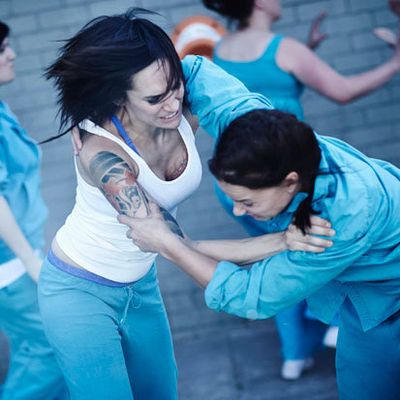
Australian prison drama Wentworth seems like a natural companion to Orange Is the New Black: Both are set in women’s prisons, include charismatic brunette lesbians who find ways to make others do their bidding, and feature a variety of actresses turning in wonderful, deeply unglamorous performances. But Wentworth isn’t a vaguely inspiring dramedy; it’s a ruthlessly dark drama, more like Breaking Bad with ten Gus Frings, or Deadwood but with competing Swearingens. It’s tragic and gripping, and one of very few recent shows that has truly shocked me. On the one hand, I wish there were a hundred more shows like Wentworth, intricately plotted and predominately about women. On the other, given the show’s all-encompassing sense of brutality, I don’t know if I could take it.
Wentworth, now on Netflix, premiered in Australia in 2013, a reimagining of sorts of a popular Australian drama from the ‘80s, Prisoner. I didn’t know that when I watched it, and I don’t feel much the poorer for it — the series stands on its own and then some. We’re introduced to prison through the eyes of Bea Smith (Danielle Cormack), newly incarcerated after being convicted of the attempted murder of her husband. She meets Franky (Nicole da Silva), the prison queen-pin and resident punky lesbian whose true passions include doing push-ups, wearing push-up bras, and flirting with anything that walks. There’s Liz (Celia Ireland), the curly haired, middle-aged peacekeeper, and the maternal, mostly upbeat Doreen (Shareena Clanton). We get to know the guards and the wardens, too, and as you might expect, they also have dark sides. But where Orange shows over and over that many of its characters are the victims of circumstance, of the broken American prison system, casualties of the corrupt war on drugs, etc., Wentworth takes a more Oz-like approach. Most of these people did something pretty bad, and many are violent offenders. The show’s violence is emotionally shattering, and even as characters’ backstories humanize and explain some of their behavior, there’s no moment of permissiveness: Bad acts don’t suddenly become good acts when they’re contextualized. They just become more inevitable.
Wentworth’s careful plotting is the shining example of what can happen when a show genuinely tries. You can do season-long mysteries with meaningful payoff; you can do two in a row, in fact. It helps that the day-to-day human dramas take center stage, and there’s something very storytelling–friendly about the fact that prison is an information economy. There’s no shiv as powerful as “having” something on someone, nothing so potent as a carefully deployed “I know something you wish I didn’t.” (True for both staff and inmates.) This is a corrupt ecosystem that prizes information and permits violence, and that infects every interaction, even between alleged allies.
That’s what makes Wentworth a good show, smart and competent. What dazzled me about the show, though, was how capably it holds its characters in human regard. We see these characters behave abominably, dangerously, hurtfully. Some of them kill each other. There’s a cruelty and carelessness that pervades the prison. And yet the show presents each of them in a way that says, “You know, that’s a person,” and it does this without romanticizing or glamorizing their their actions. We see the characters like and love each other, and even the ones who seem most villainous have someone who sees their true light — not because they’re “good,” but because we seek humanity in each other. Some shows glorify characters’ violence or villainy, like on Justified, when you’re supposed be charmed by Raylan’s short fuse, or on True Detective, where beating the crap out of someone is What Men Do, and we all need to respect that, dammit. In the past few years, I’ve become really turned off by TV violence, by how often we see characters beat each other to death, by the gurgling sounds of someone spitting out blood. The savagery on Wentworth bothered me a lot less than I expected, though, largely because of how character-driven it was: Oh, she would be a jab-jab kind of boxer, or she would cleverly develop a thumbtack gun, or she is the kind of person to turn a paintbrush into a shiv. Who’s a planner, who’s a spur-of-the-moment grabber, who sends the muscle, who does it themselves. There’s also a death scene that knocked me on my ass, pushing itself right to the edge of ridiculous.
Wentworth isn’t as big on symbolism as some of its brethren, but the one recurring image is of hands, particularly of hands being injured in a variety of ways. (It happens a lot; if you have a thing about hands, you won’t be able to watch this show, I am sorry to say.) Hands getting crushed, burned, punctured reflect how difficult ordinary things become when your hands are broken, when you’re behind bars. Making a phone call, having a meal, getting laid — nothing’s straightforward. And if you were that frustrated and strangled by circumstance, well, what wouldn’t you do? Broken hands make for crooked fists.




